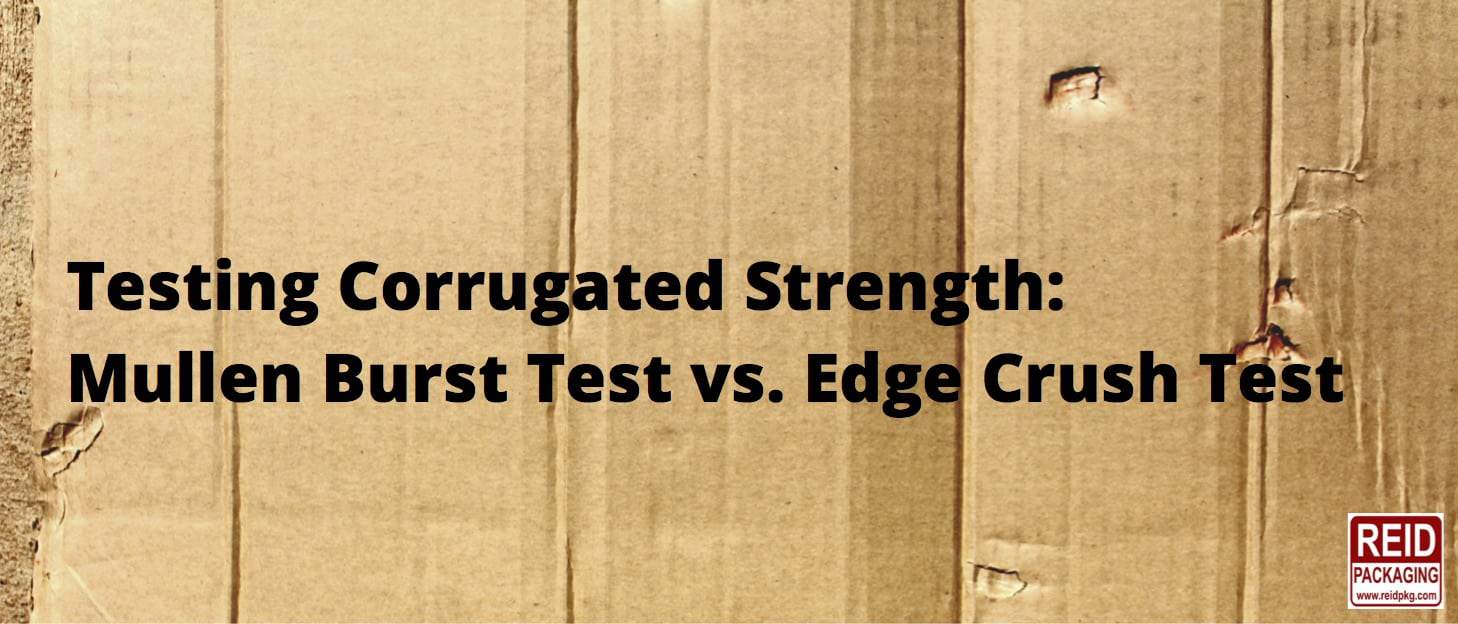Testing Corrugated Strength:
Mullen Burst Test versus Edge Crush Test
If you’ve ever received a shipment that arrived in a damaged box, then you know how important it can be to get box strength right. In fact, your product, or your whole shipment, depends on it. But how do we measure box strength and what can we do to ensure a correct box strength for the contents of the box?
In order to answer this question, we have to go back to the 90s.
For many years, the regulating body that controlled the truck and rail freight industry had one standard that they worked with in determining box strength. They all worked with the Mullen Burst Test. This was considered industry standard; it was the only game in town.
The Mullen Burst Test uses a pressurized diaphragm to measure how much pressure (in pounds per square inch) the side of a corrugated box can take before it breaks. And analogy to this would be: how hard do you have to punch the side of a box to break through it. The harder you had to punch, the stronger the box was, full stop.
But then the 90s happened.
A major change happened in the corrugated industry in the 90s. Corrugators started to use a higher percentage of recycled material. Recycled material became more abundant then, and it was cheaper than using new material (as well as being more environmentally friendly). But recycled paper is different than new paper. The fibers in new paper are long and strong and they are highly organized to be running in the same direction. The fibers in recycled paper are shorter and less organized.
What that meant for box making is that corrugated material started to have lower Mullen Burst Test ratings for what should be the same box construction, because of the different qualities of recycled versus new material.
But there was a catch.
While the Mullen Bursting Test ratings changed, some people noticed that the vertical tensile strength of the box was still strong. In other words, the boxes could still be stacked as high, with the same amount of weight, as long as the contents in the box didn’t move and impact the side walls. In other words, the corrugated might burst more easily, but it wouldn’t crush.
The Edge Crush Test (ECT)
That’s when the National Motor Freight Traffic Association (NMFTA) changed the standard to what’s called an Edge Crush Test or ECT. ECT measures the strength of a corrugated box in a fundamentally different way. Instead of using the “punch strength” of the material, it measures how much weight would need to be put over the edge of the corrugated before it crushes. You could think of this as: how much could you weigh and sit on the box before crushing it.
What the NMFTA realized is that the most important metric for shipping boxes is how high you can stack them. ECT more directly related to that metric. It was simple: ECT measured how much weight a box could hold above it before it crushed.
Here’s a video of a practical box crush test being performed on a standard corrugated box. We add weight (in the form of pressure) until the box begins to crush.
What Now? Determining the most relevant strength test for your application
That was in the 90s. Nearly 30 years later, we now see some Box Manufacturer’s Certification (BMC) stamps that give Mullen and some that give ECT. Perhaps you are asking, which is the most relevant for my purposes? What strength is the one I should care about?
When ECT is most relevant
If you are packaging items that will not move in shipment, that will not exert lateral force on the sides of the box, and will not go through many different nodes of shipment, then ECT is the most relevant metric for you. All you really care about is the stacking strength of the box. How much weight before the box crushes?
When Mullen Burst Testing is most relevant
A Mullen Burst Test is most relevant if you are send items that can move in the box (ball bearings, plastic beads, and round fruits are common examples) or that will exert pressure on the side of the box. It is also best if you are sending boxes on a shipment path that will see them being loaded and unloaded at many different nodes of transport (onto a truck, off the truck and onto a rail car, off the rail car and into a shipping container, for instance). The burst test takes into account the strength of the box even when it is being pressured from the side, and these shipping paths will exert more lateral pressure on the box over time.
Anatomy of the BMC
The Box Manufacturer’s Certification stamp (BMC) is added to every corrugated fiberboard box in order to ensure that the shipper can properly handle the box without damaging it or what’s inside it. The BMC is regulated by NMFC Item 222. Every BMC contains information about either Mullen Burst Rating (combined with the minimum combined weight of facings) OR an edge crush rating. This allows for the smooth transport of your valuable products and materials.
In addition, every BMC also lists:
- The number of corrugated walls.
- The maximum sum of outside dimensions.
- The maximum allowable gross weight.
A strong box built specifically for your needs
As always, get in touch with Reid Packaging if you need help figuring out the right custom box for your shipping needs.

